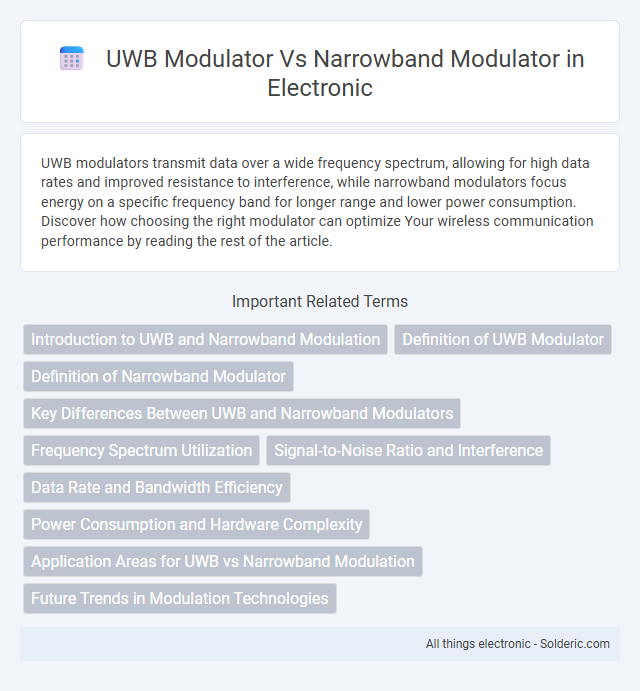UWB modulators transmit data over a wide frequency spectrum, allowing for high data rates and improved resistance to interference, while narrowband modulators focus energy on a specific frequency band for longer range and lower power consumption. Discover how choosing the right modulator can optimize Your wireless communication performance by reading the rest of the article.
Comparison Table
| Feature | UWB Modulator | Narrowband Modulator |
|---|---|---|
| Frequency Range | Wide spectrum, typically 3.1 to 10.6 GHz | Narrow spectrum, typically a few kHz to MHz |
| Bandwidth | Greater than 500 MHz | Less than 1 MHz |
| Data Rate | High, up to Gbps | Moderate, typically Mbps |
| Power Consumption | Low to moderate | Low |
| Interference Susceptibility | Low due to wide spectrum | Higher due to narrow bandwidth |
| Range | Short to medium (meters) | Medium to long (up to kilometers) |
| Applications | Localization, imaging, short-range high data communication | Long-range communication, broadcasting, narrowband IoT |
Introduction to UWB and Narrowband Modulation
Ultra-wideband (UWB) modulation transmits signals over a broad spectrum exceeding 500 MHz, enabling high data rates and precise ranging capabilities critical for applications like radar and short-range wireless communication. Narrowband modulation confines signals to a limited frequency range, optimizing energy efficiency and reducing interference for long-distance communication in systems such as narrowband IoT and traditional radio links. The fundamental difference lies in bandwidth utilization, where UWB emphasizes spectrum spread for enhanced resolution and robustness, while narrowband focuses on spectral efficiency and power conservation.
Definition of UWB Modulator
A UWB modulator generates ultra-wideband signals by transmitting data across a very wide frequency spectrum, typically exceeding 500 MHz, enabling high data rates and precise localization. In contrast, narrowband modulators operate within a limited frequency range, concentrating power on a specific carrier frequency for longer-range communication with reduced bandwidth. UWB modulators are essential in applications requiring low power consumption and minimal interference, such as radar imaging and wireless sensor networks.
Definition of Narrowband Modulator
A Narrowband Modulator processes signals within a limited frequency range, typically focusing on a single or small band of frequencies to optimize signal clarity and reduce interference. Unlike Ultra-Wideband (UWB) modulators that operate over a wide spectrum for high data rates and precise localization, narrowband modulators emphasize spectral efficiency and energy conservation. Your choice between these modulators depends on application requirements like bandwidth, power consumption, and signal range.
Key Differences Between UWB and Narrowband Modulators
UWB modulators transmit data over a wide frequency spectrum, typically exceeding 500 MHz, enabling high data rates and precise time-of-flight measurements for applications like radar and positioning systems. Narrowband modulators operate within a confined frequency range, usually less than 100 MHz, offering better signal robustness and lower power consumption ideal for traditional communication systems. The primary differences lie in bandwidth usage, data transmission speed, and application suitability, where UWB excels in high-resolution sensing and narrowband favors efficient, long-range communication.
Frequency Spectrum Utilization
UWB modulators utilize an extremely wide frequency spectrum, typically spanning several gigahertz, enabling high data rates and precise location tracking through ultra-short pulses. Narrowband modulators operate within a limited, specific frequency band, providing efficient transmission over longer distances with reduced interference. The broad spectral usage of UWB allows for better resistance to multipath fading, whereas narrowband modulation focuses power within a tighter bandwidth for energy efficiency and regulatory compliance.
Signal-to-Noise Ratio and Interference
UWB modulators generally offer a higher Signal-to-Noise Ratio (SNR) due to their wide frequency spectrum, which enables better noise averaging and improved resistance to narrowband interference. Narrowband modulators, restricted to a limited frequency range, are more susceptible to tuning conflicts and signal degradation in congested environments. Your choice between UWB and narrowband modulators should consider the operating environment's interference levels and the required communication reliability.
Data Rate and Bandwidth Efficiency
UWB modulators offer significantly higher data rates by transmitting over a wide frequency spectrum, enabling rapid exchange of large data volumes in short bursts. Narrowband modulators operate within limited frequency bands, resulting in lower data rates but improved bandwidth efficiency for steady, long-distance communication. Your choice depends on whether ultra-fast data transfer or spectral efficiency in constrained channels is the primary requirement.
Power Consumption and Hardware Complexity
UWB modulators generally consume more power due to their wide frequency spectrum and high data rate transmission, while narrowband modulators are more power-efficient with simpler circuitry optimized for specific frequency bands. The hardware complexity of UWB modulators is significantly higher, requiring advanced signal processing and broadband filters, compared to the simpler, more compact design of narrowband modulators. Your choice between these modulators should consider the trade-off between power consumption and complexity based on application requirements.
Application Areas for UWB vs Narrowband Modulation
UWB modulators are ideal for high-resolution radar systems, short-range wireless communications, and through-wall imaging due to their wide frequency spectrum, enabling precise localization and multipath resistance. Narrowband modulators excel in traditional cellular networks, broadcast systems, and long-range communication, offering efficient bandwidth usage and robust signal integrity. Your choice depends on whether ultra-wide bandwidth for high data rates and spatial accuracy or narrow bandwidth for extended range and spectral efficiency is prioritized.
Future Trends in Modulation Technologies
Future trends in modulation technologies highlight the growing adoption of Ultra-Wideband (UWB) modulators due to their superior data rate capabilities and precise localization in complex environments, which surpass the limitations of traditional narrowband modulators. Innovations in UWB technology emphasize enhanced spectral efficiency and robustness against multipath interference, enabling next-generation applications in IoT, automotive radar, and high-speed wireless communication. Meanwhile, narrowband modulators continue to evolve with low power consumption and improved noise performance, maintaining relevance for long-range, low-data-rate transmissions in industrial and remote sensing networks.
UWB modulator vs narrowband modulator Infographic

 solderic.com
solderic.com